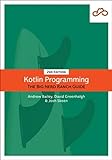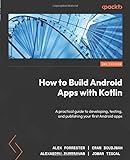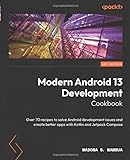To invoke Dart code from Kotlin code, you can use the platform channel provided by Flutter. This allows communication between the Dart and Kotlin code in your app.
First, define a method in your Dart code that you want to invoke from Kotlin. Then, create a MethodChannel object in your Kotlin code and specify the channel name that corresponds to the one in your Dart code. Use the invokeMethod function on the MethodChannel object to call the Dart method from Kotlin.
Ensure that you have set up the necessary dependencies and configurations in your project to enable communication between Dart and Kotlin code. This may involve adding the appropriate plugins and packages to your project.
By following these steps, you can successfully invoke Dart code from Kotlin code in your Flutter app.
What is the role of codec in encoding and decoding data between dart and kotlin using platform channels?
The role of codec in encoding and decoding data between Dart and Kotlin using platform channels is to convert data between formats that are compatible with both languages. Codecs help ensure that data can be properly serialized and deserialized when passing information between Dart and Kotlin code through platform channels. This is important for ensuring that communication between the two languages is seamless and efficient.
How to ensure proper error handling when invoking dart code from kotlin?
To ensure proper error handling when invoking Dart code from Kotlin, you can follow these steps:
- Use the Result class in Kotlin to handle success and error cases: Define a sealed class that represents the result of invoking the Dart code, with subclasses for success and error cases. Use the Result.Success and Result.Error classes to wrap the return value or error message from the Dart code.
- Use a try-catch block in Kotlin to catch any exceptions thrown by the Dart code: Surround the invocation of the Dart code in a try-catch block to handle any exceptions that may occur. Catch any exceptions and wrap them in a Result.Error instance to handle them in the calling code.
- Use a callback mechanism to notify the caller of the result: Define a callback interface in Kotlin that can be implemented by the caller to receive the result of the Dart code invocation. Pass an instance of the callback interface to the Dart code and invoke it with the result in the success case.
- Ensure proper error checking and handling in the Dart code itself: Implement error checking and handling in the Dart code to ensure that any potential errors are caught and handled properly. Use the throw statement to throw exceptions in the Dart code when errors occur.
By following these steps, you can ensure proper error handling when invoking Dart code from Kotlin, allowing you to handle both success and error cases effectively.
How to optimize communication performance between dart and kotlin code using platform channels in Flutter?
To optimize communication performance between Dart and Kotlin code using platform channels in Flutter, you can follow these best practices:
- Limit the frequency of method calls: Minimize the number of method calls between Dart and Kotlin code to reduce overhead and improve performance. Group multiple operations into a single method call when possible.
- Use efficient data serialization: Choose efficient data serialization methods such as JSON or Protocol Buffers to serialize and deserialize data between Dart and Kotlin code. Avoid unnecessary conversions that can slow down communication.
- Optimize data transfer: Use proper data types and data structures for data transfer to reduce memory consumption and improve performance. Choose lightweight data types and collections for better efficiency.
- Implement error handling: Proper error handling is essential for robust communication between Dart and Kotlin code. Handle exceptions and errors gracefully to prevent crashes and ensure smooth communication.
- Minimize data transfer size: Reduce the size of data transferred between Dart and Kotlin code by sending only necessary information. Avoid sending large datasets or unnecessary data to improve performance.
- Use asynchronous communication: Use asynchronous communication methods such as async/await in Dart and coroutines in Kotlin to improve responsiveness and efficiency in communication between the two languages.
- Profile and optimize: Monitor and profile the communication performance between Dart and Kotlin code using profiling tools such as Flutter DevTools or Android Profiler. Identify bottlenecks and optimize the communication code for better performance.
By following these best practices, you can optimize communication performance between Dart and Kotlin code using platform channels in Flutter and ensure a smooth and efficient interaction between the two languages.
How to leverage platform channels for bi-directional communication in Flutter?
To leverage platform channels for bi-directional communication in Flutter, you can follow these steps:
- Define method channels: First, define method channels in your Flutter app to establish communication with the platform (Android or iOS).
- Implement platform code: Write the necessary platform-specific code in your native Android or iOS files to handle the method calls from Flutter and send responses back.
- Invoke methods from Flutter: Use the platform channels in your Flutter code to trigger method calls to the platform. You can pass parameters along with the method call if needed.
- Handle platform responses: In your platform-specific code, implement the necessary logic to handle the method calls from Flutter and return responses back to the Flutter side.
- Listen for events: You can also use event channels to listen for events from the platform in Flutter. This allows for bi-directional communication where the platform can send updates or notifications to the Flutter app.
- Test and debug: Make sure to test the bi-directional communication flow thoroughly and debug any issues that may arise during the development process.
By following these steps, you can effectively leverage platform channels for bi-directional communication in Flutter and enhance the functionality of your app by integrating native platform features.
What is the best approach for maintaining code clarity when invoking dart code from kotlin in a Flutter project?
To maintain code clarity when invoking Dart code from Kotlin in a Flutter project, consider the following best practices:
- Follow consistent naming conventions: Use meaningful and descriptive names for variables, classes, and functions in both Kotlin and Dart code to make it easier to understand the codebase.
- Document functions and classes: Add comments and documentation to explain the purpose and functionality of each function and class, especially when invoking Dart code from Kotlin.
- Use appropriate data types: Ensure that the data types used in Kotlin and Dart code are consistent and compatible to avoid errors and confusion.
- Organize code logically: Structure your code in a logical and organized manner, following best practices for code architecture such as MVP or MVVM to make it easier to navigate and maintain.
- Limit the use of complex logic: Keep the logic in both Kotlin and Dart code as simple and straightforward as possible to improve readability and maintainability.
- Use consistent coding style: Maintain a consistent coding style throughout the project, including formatting, indentation, and spacing, to make the codebase more cohesive and easier to read.
- Refactor when necessary: Regularly review and refactor the codebase to eliminate any redundant or unnecessary code, improve performance, and enhance code clarity.









